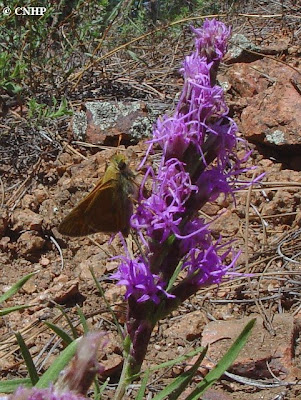Hesperia leonardus montana (Pawnee montane skipper)
The Pawnee montane skipper (PMS) butterfly (Hesperia leonardus montana) is listed as threatened under the endangered species act. From 1996 to 2002, four separate wildfires in the South Platte River Valley burned a large portion of the historical habitat for the PMS butterfly. This project was established in 2002 to implement an annual monitoring program to document PMS habitat condition and trends of population abundance in both burned and unburned areas.
A high intesity burn area from 2002 after the Hayman Fire.
2009 was a wet year, with rainfall at or above the 100-year mean for four of the six months during the growing season (March to August). The increased rainfall resulted in an abundance of blooming Liatris punctata (prairie gayfeather, the primary nectar source for PMS adults) and Bouteloua gracilis (blue grama, the primary food for PMS catepillars).
A Pawnee montane skipper feeding on nectar from Liatris punctata flowers
Between 2002 and 2009, the general trend has been for increases and then stabilization in the counts of PMS per acre at the unburned and low severity burn sites while counts at the moderate-to-high severity burn sites have lagged behind. In 2009, 1.52 PMS per acre were counted at unburned transects, which is near the high count for the eight years of monitoring, but it is still only about 40% of the maximum PMS per acre of 3.6 recorded in 1986.
Results of this 7 year study suggest that PMS were eradicated from the moderate-to-high severity burn areas and as time passes, PMS populations surviving the fire in unburned and low severity burn areas have increased in size and are subsequently dispersing into the moderate-to-high severity burn areas of the fire. Viability of the PMS population may depend upon maintaining and increasing PMS populations in moderate-to-high severity burn areas.
For more information about this ongoing study, see the full report on the reports page of our website.






No comments:
Post a Comment
Thanks for your comment!
Please note that all comments are moderated, so there may be a delay of some hours (especially over the weekend or at night Colorado time) before your comment shows up.